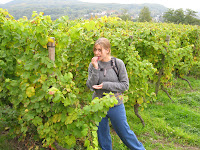




Last Saturday we made a pilgrimage to the Ahr valley, which is the northernmost mecca of red wine making. After a bitterly cold morning and unsuccessful perusing of the final flea market of the year, we piled into the Peugeot station wagon with our friends Jeanine and Markus and drove 25 km southeast to the village of Altenahr. Altenahr, like all of the other villages along the Ahr river, is a picturesque cluster of houses and restaurants that thrive on the business of elderly Dutch and German tourists who come to hike among the vineyards, drink wine, and sing songs with neverending choruses.
We started out by hiking up to the ruins of an old castle that towers above Altenahr like a church steeple above a town square. From there we walked along a ridge to the rotwein weg, or red wine path, which is a dirt walking trail that crosses through vineyards whose rows climb up the steep southern slopes of the Ahr valley. Along the path, vendors sell local wines out of the back of their cars to thirsty nordic walkers (people who hike with ski poles, not blond-bearded guys walking around with a horned helmets). We sampled the Federweißer (fresh, still-fermenting wine) and a lovely Fall rosé named Weißherbst. The sun was shining and the temperature never broke 55 F, which was fortunate because the brisk air was the only thing keeping me from laying down among the vines and taking a nap.
I learned that viticulture in the Ahr valley dates back to the 3rd century. Apparently the Romans were not satisfied with just drinking mead and beer, and transplanted some grape vines in strategic locations. I would have thought that the local Germanic tribes hassled the occupying Romans too much for them to do pursue any leisurely pastimes like grape cultivation and winemaking, but that just goes to show you how little I know. Who among centurions or barbarians could resist the bouquet of a fine pinot noir? Certainly not this american.
While the rest of Germany is lauded for reisling, the region through which we hiked is renowned for producing excellent Spätburgunder, the german word for pinot noir (insert favorite Sideways quote here). This is due to an advantageous geological situation in which the moderate temperatures of the greater Rhine valley, the slate covered slopes of the Ahr valley that hold the sun's heat throughout the night, and the deep cold-trapping river bottom team together to provide a suitable climate for red grapes. As we walked along the trail, the volcanic slate was constantly coming loose and sliding down the hill in pie-sized chunks, giving the odd feeling that those hills could never survive the sloughing off of its members, despite the fact that it had been happening for at least nineteen hundred years.
We followed the switchbacks down into the town of Rech. On the far side across the river is a converted barn that functions as restaurant for just four months out of the year. We took a seat around a barrel and ordered up some of Rhineland's finest spreads on homemade bread. Pretty standard fare: headcheese, liverwurst, congealed bacon grease with crunchy bits of bacon, blood sausage, and oddly enough a plain old slice of cheese. It may been the cold weather or the hiking but Katie made her most impressive showing to date in the category of foreign food eating.
A large group of middle-aged women were singing an unknown song as we waited for the train back to Altenahr. They stopped once we climbed aboard and settled down into the warm seats. We looked out the windows as the sun sunk behind the hills of the valley and the long shadows faded into dark evening tones. Out of the train, back in the car, driving towards Bonn, almost dark, and then finally dark when we arrived back at home.
I could have easily gone to bed, but the final game of Rugby World Cup was going to start in a few hours. Drat. Good day though.








